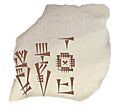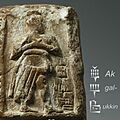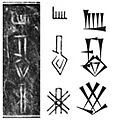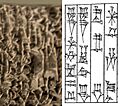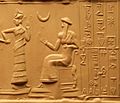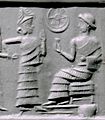Sumerian King List facts for kids
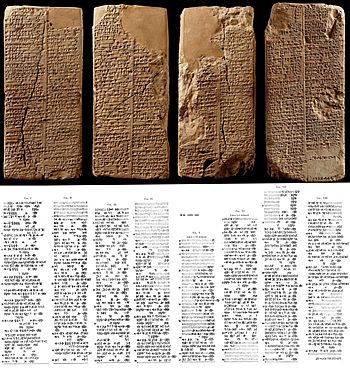
The Sumerian King List inscribed onto the Weld-Blundell Prism, with transcription.
|
|
| Original title | 𒉆𒈗 (Nam-Lugal "Kingship"). |
|---|---|
| Translator |
|
| Country | Sumer (ancient Iraq) |
| Language | Sumerian |
| Subject | Regnal list |
| Genre | Literary |
| Set in | Late-third to early-second millennia BC |
|
Publication date
|
Ur III to Old Babylonian periods |
|
Published in English
|
AD 1911–2014 |
| Media type | Clay tablets |
| Text | Sumerian King List at the Electronic Text Corpus of Sumerian Literature |
The Sumerian King List (often called SKL) is a very old story written in the Sumerian language. It was probably made to help different cities and kingdoms in southern Mesopotamia show that their rulers had a right to be in charge.
The list does this by naming Sumerian cities, the kings who ruled there, and how long they were kings. Some of the early kings are said to have ruled for thousands of years! The oldest known version of the list is from the Third Dynasty of Ur (around 2112–2004 BC). It showed power moving from Kish, the first city to have kings, to Akkad. Later versions, from the Old Babylonian period, listed many cities where kingship moved around. This showed a belief that kingship would always move from one city to the next.
The most famous version of the SKL is on the Weld-Blundell Prism. It starts with kings who lived before a great flood. After the flood, kingship went to Kish. The list ends with a group of kings from Isin (early second millennium BC), who are also known from other historical records.
Many copies of the SKL exist, mostly from the Old Babylonian period. They were found in southern Mesopotamia. These copies are not all exactly the same. Some parts might be missing, or the order of kings might be different. King names might be missing, or their reign lengths might change. These differences happened because of copying mistakes or because people changed the text on purpose.
In the past, the Sumerian King List was seen as a very important source for understanding the history of early Mesopotamia. However, newer studies show that using the SKL can be tricky. It should be used carefully when studying ancient Mesopotamia.
Contents
- What is the Sumerian King List?
- What the List Contains
- Rulers in the Sumerian King List
- Kings Before the Flood
- First Kings of Kish
- First Kings of Uruk
- First Kings of Ur
- Kings of Awan
- Second Kings of Kish
- Kings of Hamazi
- Second Kings of Uruk
- Second Kings of Ur
- Kings of Adab
- Kings of Mari
- Third Kings of Kish
- Kings of Akshak
- Fourth Kings of Kish
- Third Kings of Uruk
- Kings of Akkad
- Fourth Kings of Uruk
- Gutian Rulers
- Fifth Kings of Uruk
- Third Kings of Ur
- Kings of Isin
- Images for kids
- See also
What is the Sumerian King List?
The text is best known today as the Sumerian King List. Scholars often shorten this to SKL. Another name for it is the Chronicle of the One Monarchy. This name shows the idea that, according to the text, only one city could be the main power in Mesopotamia at a time.
In ancient times, the SKL was called "nam-lugal", which means "kingship". It is important to know that the Sumerian King List is not just one single text. Instead, it is a story that existed in different versions over time. Parts were missing, arranged differently, and details about kings changed.
Modern historians use numbers to talk about times when one city ruled without interruption. For example, the Ur III dynasty means the third time the city of Ur was the main power, according to the SKL. This numbering (like Kish I, Uruk IV, Ur III) was not in the original text. Also, the modern idea of a "dynasty" usually means rulers from the same family. In ancient Mesopotamia, this was not always true. Even though the SKL sometimes says rulers were family, kingship was given to the city, not just to individual rulers.
What the List Contains
The different copies of the Sumerian King List are not exactly the same. This is partly because some tablets are broken. It is also because scribes made mistakes when copying. Sometimes, changes were made on purpose over time. For example, the part about kings before the great flood is not in every copy. This includes many texts found in Nippur, where most SKL versions were discovered.
Also, the order of some kings or groups of kings might be different between copies. Some groups of kings that were listed separately in one version might be combined in another. The lengths of individual reigns can also vary. Some kings might even be left out completely.
The summary below uses the version from the Electronic Text Corpus of Sumerian Literature. This version mainly follows the text of the Weld-Blundell prism. It also notes differences found in other versions.
Kings Before the Great Flood
This part of the list is not found in every copy. It starts by saying: "After the kingship descended from heaven, the kingship was in Eridu." Two kings of Eridu are named. Then, the city "fell," and "kingship was taken to Bad-tibira." This pattern of cities getting kingship, then falling, and being replaced by another city, happens throughout the entire text. It often uses the same words.
This first section lists eight kings who ruled over five cities. These cities were Eridu, Bad-tibira, Larag, Zimbir, and Shuruppag. The list also gives the length of each king's rule. In this section, the reigns are very long, from 28,800 to 43,200 years. The total for all these kings is 241,200 years. This section ends with the line: "Then the flood swept over." One of the kings mentioned here is the ancient god Dumuzid.
Kings After the Great Flood
The list continues with a famous line: "After the flood had swept over, and the kingship descended from heaven, the kingship was in Kish." This part then lists 23 kings of Kish. Their reigns ranged from 300 to 1500 years, totaling 24,510 years. The exact number of years can change between different copies of the list.
Usually, no other details are given about these kings, except how long they ruled and if they were the son of the previous king. For example, "Mashda, the son of Atab, ruled for 840 years." However, there are a few exceptions. Etana is described as "who ascended to heaven and consolidated all the foreign countries." Enmebaragesi "made the land of Elam submit." Enmebaragesi is the first king in the Sumerian King List whose name has been found on other ancient writings from his time. His successor, Aga of Kish, is the last king mentioned before Kish fell. Aga also appears in the story Gilgamesh and Aga.
The next parts of the list, up to Sargon of Akkad, show a steady line of cities and kings. There are usually not many details beyond how long each king ruled. Each entry is set up the same way: the city with kingship is named, then one or more kings and their reign lengths. Then, a summary and a line saying where kingship went next.
Here is an example: In Ur, Mesannepada became king; he ruled for 80 years. Meskiagnun, the son of Mesannepada, became king; he ruled for 36 years. Elulu ruled for 25 years. Balulu ruled for 36 years. 4 kings; they ruled for 171 years. Then Ur was defeated and the kingship was taken to Awan.
Individual reigns vary in length. Some kings, like Lugalbanda of Uruk, ruled for 1200 years. Others, like some kings of Akshak, ruled for only six years. On average, the number of years kings ruled gets shorter as you go down the list. Some city names, such as Uruk, Ur, and Kish, appear more than once.
The earlier part of this section mentions kings also known from other ancient stories. These include Dumuzid the Fisherman and Gilgamesh. However, almost no king from the early part of this section has been found in writings from the actual time they were supposed to live.
This section also describes a group of kings from Mari. Mari is a city outside Sumer itself. It was important in Mesopotamian history. The next group of kings from Kish includes a single ruler, Kug-Bau. She was a "woman tavern keeper" and is thought to be the only queen listed in the Sumerian King List. The last two groups of kings in this section, the fourth of Kish and the third of Uruk, connect to the next part of the list. Sargon of Akkad is mentioned as a servant to Ur-Zababa of Kish. Sargon defeated Lugal-zage-si of Uruk before starting his own group of kings.
From Akkad to Isin
This section talks about the famous Akkadian ruler Sargon and the kings who came after him. After the entry for Shar-kali-sharri, the Sumerian King List asks: "Then who was king? Who was not king?" This suggests a time of confusion, which might show the difficult period when the Akkadian Empire ended. Four kings are mentioned who ruled for only three years in total. Of the Akkadian kings after Shar-kali-sharri, only Dudu and Shu-turul have been found in writings from the Akkadian period.
The Akkadian kings are followed by the fourth group of kings from Uruk. Two of these kings, Ur-nigin and his son Ur-gigir, appear in other ancient writings. Kingship then went to the "land" or "army" of Gutium. It was said that at first, they had no kings and ruled themselves for a few years. After this short time, 21 Gutian kings are listed. Then Gutium fell, and kingship went to Uruk. Only one ruler is listed for Uruk during this time (Utu-hengal), before kingship moved to Ur.
The Third Dynasty of Ur had 5 kings who ruled between 9 and 46 years. No other details about their actions are given. The Sumerian King List says that after Ur's rule ended, "The very foundation of Sumer was torn out." Then kingship went to Isin. The kings of Isin are the last group included in the list. This group had 14 kings who ruled between 3 and 33 years. Like with the Ur III dynasty, no details are given about the reigns of individual kings.
Summary of the List
Some versions of the Sumerian King List end with a summary of the kings after the flood. This summary mentions the number of kings and their total years of rule for each city. It also says how many times that city had kingship. For example: "A total of 12 kings ruled for 396 years, 3 times in Urim." The very last line adds up the numbers for all these groups of kings: "There are 11 cities, cities in which the kingship was exercised. A total of 134 kings, who altogether ruled for 28876 + X years."
Rulers in the Sumerian King List
The dates for early rulers are estimates. They are based on what archaeologists have found. For most kings before the Akkadian Empire, the King List is the only source of information. Starting with Lugal-zage-si and the Third Dynasty of Uruk, we have a better idea of how these rulers fit into the timeline of the ancient Near East. The shorter timeline (short chronology) is used here.
Kings Before the Flood
None of the kings listed before the great flood have been proven to be real by archaeological digs or ancient writings. While there is no proof they ever ruled, the Sumerians believed they lived in a mythical time before the huge flood.
The reigns of these "antediluvian" (before the flood) kings were measured in very large Sumerian numbers. These included sars (units of 3,600 years), ners (units of 600 years), and sosses (units of 60 years). People have tried to change these numbers into more realistic lengths of rule.
| Ruler | Length of reign (in years) | Notes |
|---|---|---|
|
||
| Alulim | 28,800 years | |
| Alalngar | 36,000 years | |
|
||
| En-men-lu-ana | 43,200 years | |
| En-men-gal-ana | 28,800 years | |
| Dumuzid, the Shepherd | 36,000 years | This Dumuzid was later seen as a god. |
|
||
| En-sipad-zid-ana | 28,800 years | |
|
||
| En-men-dur-ana | 21,000 years | |
| Ubara-Tutu | 18,600 years | In the Epic of Gilgamesh, he is the father of Utnapishtim. |
|
||
First Kings of Kish
| Ruler | Length of reign (in years) | Notes |
|---|---|---|
|
||
| Jushur | 1,200 years | Kings before Etana are not proven by archaeology. |
| Kullassina-bel | 960 years | |
| Nangishlishma | 670 years | |
| En-tarah-ana | 420 years | |
| Babum | 300 years | |
| Puannum | 840 years | |
| Kalibum | 960 years | |
| Kalumum | 840 years | |
| Zuqaqip | 900 years | |
| Atab | 600 years | |
| Mashda | 840 years | Son of Atab. |
| Arwium | 720 years | Son of Mashda. |
| Etana | 1,500 years | Called "the shepherd, who ascended to heaven." There is a story about Etana. |
| Balih | 400 years | Son of Etana. |
| En-me-nuna | 660 years | |
| Melem-Kish | 900 years | Son of En-me-nuna. |
| Barsal-nuna | 1,200 years | |
| Zamug | 140 years | Son of Barsal-nuna. |
| Tizqar | 305 years | Son of Zamug. |
| Ilku | 900 years | |
| Iltasadum | 1,200 years | |
| Enmebaragesi | 900 years | The earliest ruler on the list confirmed by archaeology. He made the land of Elam submit. |
| Aga of Kish | 625 years | Son of Enmebaragesi. He fought Gilgamesh in a story. |
|
||
First Kings of Uruk
| Ruler | Length of reign (in years) | Notes |
|---|---|---|
| Mesh-ki-ang-gasher of E-ana | 324 years | Son of Utu. |
|
||
| Enmerkar | 420 years | Son of Mesh-ki-ang-gasher. He built Uruk. |
| Lugalbanda | 1,200 years | Called "the shepherd." |
| Dumuzid the Fisherman | 100 years | A fisherman from Kuara. He was captured by Enmebaragesi. |
| Gilgamesh | 126 years | Lord of Kulaba. He was a contemporary of Aga of Kish. |
| Ur-Nungal | 30 years | Son of Gilgamesh. |
| Udul-kalama | 15 years | Son of Ur-Nungal. |
| La-ba'shum | 9 years | |
| En-nun-tarah-ana | 8 years | |
| Mesh-he | 36 years | Called "the smith." |
| Melem-ana | 6 years | |
| Lugal-kitun | 36 years | |
|
||
First Kings of Ur
| Ruler | Length of reign (in years) | Notes |
|---|---|---|
| Mesh-Ane-pada | 80 years | His existence is supported by many ancient tablets. |
| Mesh-ki-ang-Nuna | 36 years | Son of Mesh-Ane-pada. |
| Elulu | 25 years | |
| Balulu | 36 years | |
|
||
Kings of Awan
This group of kings was from Elam.
| Ruler | Length of reign (in years) | Notes |
|---|---|---|
| Three kings of Awan | 356 years | |
|
||
Second Kings of Kish
| Ruler | Length of reign (in years) | Notes |
|---|---|---|
| Susuda | 201 years | Called "the fuller." |
| Dadasig | 81 years | |
| Mamagal | 360 years | Called "the boatman." |
| Kalbum | 195 years | Son of Mamagal. |
| Tuge | 360 years | |
| Men-nuna | 180 years | Son of Tuge. |
| Enbi-Ishtar | 290 years | |
| Lugalngu | 360 years | |
|
||
The First group of kings from Lagash (around 2500 – 2271 BC) is not mentioned in the King List, but we know a lot about them from other writings.
Kings of Hamazi
| Ruler | Length of reign (in years) | Notes |
|---|---|---|
| Hadanish | 360 years | |
|
||
Second Kings of Uruk
| Ruler | Length of reign (in years) | Notes |
|---|---|---|
| En-shag-kush-ana | 60 years | Said to have taken over parts of Sumer. |
| Lugal-kinishe-dudu | 120 years | |
| Argandea | 7 years | |
|
||
Second Kings of Ur
| Ruler | Length of reign (in years) | Notes |
|---|---|---|
| Nanni | 120 years | |
| Mesh-ki-ang-Nanna II | 48 years | Son of Nanni. |
|
||
Kings of Adab
Other rulers of Adab are known, but they are not in the Sumerian King List.
| Ruler | Length of reign (in years) | Notes |
|---|---|---|
| Lugal-Ane-mundu | 90 years | Known from other writings. Said to have conquered all Mesopotamia. |
|
||
Kings of Mari
Many rulers are known from Mari, but different names are mentioned in the Sumerian king list.
| Ruler | Length of reign (in years) | Notes |
|---|---|---|
| Anbu | 30 years | |
| Anba | 17 years | Son of Anbu. |
| Bazi | 30 years | Called "the leatherworker." |
| Zizi of Mari | 20 years | Called "the fuller." |
| Limer | 30 years | Called "the 'gudug' priest." |
| Sharrum-iter | 9 years | |
|
||
Third Kings of Kish
| Ruler | Length of reign (in years) | Notes |
|---|---|---|
| Kug-Bau (Kubaba) | 100 years | The only woman ruler in the King List. She was a "tavern-keeper." |
|
||
Kings of Akshak
| Ruler | Length of reign (in years) | Notes |
|---|---|---|
| Unzi | 30 years | |
| Undalulu | 6 years | |
| Urur | 6 years | |
| Puzur-Nirah | 20 years | |
| Ishu-Il | 24 years | |
| Shu-Suen of Akshak | 7 years | Son of Ishu-Il. |
|
||
Fourth Kings of Kish
| Ruler | Length of reign (in years) | Notes |
|---|---|---|
| Puzur-Suen | 25 years | Son of Kug-Bau. |
| Ur-Zababa | 400 (or 6?) years | According to the list, Sargon of Akkad was his cup-bearer. |
| Zimudar | 30 years | |
| Usi-watar | 7 years | Son of Zimudar. |
| Eshtar-muti | 11 years | |
| Ishme-Shamash | 11 years | |
| Nanniya | 7 years | Called "the jeweller." |
|
||
Third Kings of Uruk
| Ruler | Length of reign (in years) | Notes |
|---|---|---|
| Lugal-zage-si | 25 years | He defeated Urukagina of Lagash and other Sumerian cities. He was later overthrown by Sargon of Akkad. |
|
||
Kings of Akkad
| Ruler | Length of reign (in years) | Notes |
|---|---|---|
| Sargon of Akkad | 40 years | He was a cupbearer who became king. He built Agade and started the Akkadian Empire. |
| Rimush of Akkad | 9 years | Son of Sargon. |
| Manishtushu | 15 years | Older brother of Rimush, son of Sargon. |
| Naram-Sin of Akkad | 56 years | Son of Manishtushu. |
| Shar-kali-sharri | 25 years | Son of Naram-Sin. |
|
||
* Irgigi
|
4 years | |
| Dudu of Akkad | 21 years | |
| Shu-Durul | 15 years | Son of Dudu. Akkad fell to the Gutians during this time. |
|
||
Fourth Kings of Uruk
These kings might have ruled in lower Mesopotamia at the same time as the Akkadian kings.
| Ruler | Length of reign (in years) | Notes |
|---|---|---|
| Ur-ningin | 7 years | Known from other writings. |
| Ur-gigir | 6 years | Son of Ur-ningin. Known from other writings. |
| Kuda | 6 years | |
| Puzur-ili | 5 years | |
| Ur-Utu (or Lugal-melem) | 25 years | |
|
||
The Second group of kings from Lagash (before around 2093–2046 BC) is not mentioned in the King List, but we know a lot about them from other writings.
Gutian Rulers
| Ruler | Length of reign (in years) | Notes |
|---|---|---|
|
||
| Inkišuš | 6 years | |
| Sarlagab (or Zarlagab) | 6 years | |
| Shulme (or Yarlagash) | 6 years | |
| Elulmeš (or Silulumeš or Silulu) | 6 years | |
| Inimabakeš (or Duga) | 5 years | |
| Igešauš (or Ilu-An) | 6 years | |
| Yarlagab | 3 years | |
| Ibate of Gutium | 3 years | |
| Yarla (or Yarlangab) | 3 years | |
| Kurum | 1 year | |
| Apilkin | 3 years | |
| La-erabum | 2 years | |
| Irarum | 2 years | |
| Ibranum | 1 year | |
| Hablum | 2 years | |
| Puzur-Suen | 7 years | Son of Hablum. |
| Yarlaganda | 7 years | |
| Unknown | 7 years | Possibly Si'um or Si-u. |
| Tirigan | 40 days | Defeated by Utu-hengal of Uruk. |
|
||
Fifth Kings of Uruk
| Ruler | Length of reign (in years) | Notes |
|---|---|---|
| Utu-hengal | Conflicting dates (427, 26, or 7 years) | He defeated Tirigan and the Gutians. He appointed Ur-Namma as governor of Ur. |
Third Kings of Ur
| Ruler | Length of reign (in years) | Notes |
|---|---|---|
| Ur-Namma (Ur-Nammu) | 18 years | Son of Utu-Hengal. He defeated Nammahani of Lagash. |
| Shulgi | 46 years | Son of Ur-Namma. |
| Amar-Suena | 9 years | Son of Shulgi. |
| Shu-Suen | 9 years | Son of Amar-Suena. |
| Ibbi-Suen | 24 years | Son of Shu-Suen. |
|
||
Kings of Isin
These were independent Amorite states in lower Mesopotamia. The Kings of Larsa (around 1961–1674 BC) from this period are not mentioned in the King List.
| Ruler | Length of reign (in years) | Notes |
|---|---|---|
| Ishbi-Erra | 33 years | He was a contemporary of Ibbi-Suen of Ur. |
| Shu-Ilishu | 20 years | Son of Ishbi-Erra. |
| Iddin-Dagan | 20 years | Son of Shu-ilishu. |
| Ishme-Dagan | 20 years | Son of Iddin-Dagan. |
| Lipit-Eshtar | 11 years | Son of Ishme-Dagan (or Iddin-Dagan). |
| Ur-Ninurta | 28 years | |
| Bur-Suen | 21 years | Son of Ur-Ninurta. |
| Lipit-Enlil | 5 years | Son of Bur-Suen. |
| Erra-imitti | 8 years | He made his gardener, Enlil-Bani, a temporary king, then suddenly died. |
| Enlil-bani | 24 years | He was Erra-imitti's gardener. He was supposed to be a temporary king, but stayed on the throne when Erra-imitti died. |
| Zambiya | 3 years | |
| Iter-pisha | 4 years | |
| Ur-du-kuga | 4 years | |
| Suen-magir | 11 years | |
| Damiq-ilishu | 23 years | Son of Suen-magir. |
Images for kids
-
Weld-Blundell Prism: initial paragraph about rule of Alulim and Alalngar in Eridu for 64,800 years.
-
The Myth of Etana. Seal impression from the Akkadian Empire period.
-
Gilgamesh in a sculptured vase.
-
Seal impression of Mesh-Ane-pada, king of Kish.
-
Image related to Lugal-zage-si.
-
Sargon of Akkad on his victory stele.
-
Frontal view of a head, possibly Naram-Sin of Akkad.
-
Mention of the Gutian dynasty of Sumer in the tablet of Lugalanatum.
-
Utu-hengal titles on his victory stele.
-
King Ur-Nammu.
-
Portraits of Shulgi.
-
Stele of the Code of Lipit-Ishtar.
See also
 In Spanish: Lista Real Sumeria para niños
In Spanish: Lista Real Sumeria para niños



